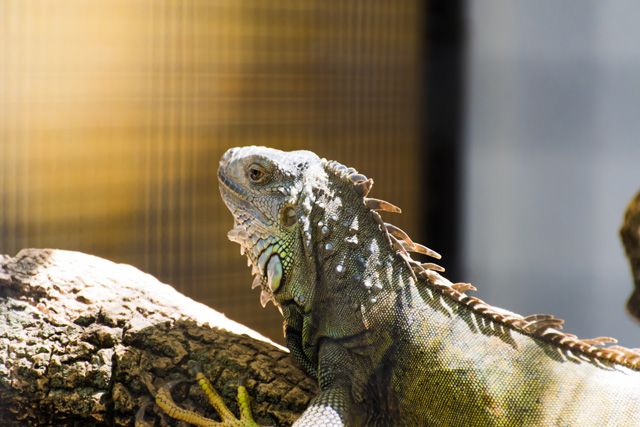Green iguanas are native to the tropical forests of Central and South America, and as such, they require a specific type of substrate that mimics their natural habitat. The best substrates for green iguanas are those that are safe, comfortable, and easy to maintain.
One of the best substrates for green iguanas is coconut fiber, also known as coir. This substrate is made from the husks of coconuts and is an excellent choice for green iguanas as it is soft and absorbent, making it comfortable for the iguana to walk and lay on. Additionally, coconut fiber is easy to clean and maintain, which is important for the overall health of your iguana.
Another great substrate for green iguanas is orchid bark. Orchid bark is a natural substrate that is soft and absorbs moisture, making it an ideal option for green iguanas. It is also easy to clean and maintain, and is affordable.
Avoid using sand or small gravel as a substrate, as it can easily get into the iguana’s eyes and nose and cause irritation. Additionally, avoid using newspapers, as it can be toxic to iguanas.
How much substrate do I need in the enclosure?
The amount of substrate you’ll need in the enclosure for your green iguana will depend on the size of the enclosure and the number of iguanas you have. A general rule of thumb is to have at least 2 inches of substrate in the enclosure. This will provide enough depth for the iguana to burrow and move around comfortably, while also allowing for easy cleaning and maintenance.
A larger enclosure or more iguanas will require more substrate to ensure that there is enough depth for all the iguanas to move around comfortably. It’s also important to note that the depth of the substrate will also depend on the type of substrate you are using. Some substrates compress over time, and may need to be replaced more frequently than others.
It’s always a good idea to monitor your iguana’s behavior and adjust the depth of the substrate as needed. Make sure the iguana has enough substrate to bury and move around comfortably, but not too much that makes it hard to spot clean the enclosure or maintain it.
In summary, a general rule of thumb is to have at least 2 inches of substrate in the enclosure, but the actual amount needed will depend on the size of the enclosure, the number of iguanas, and the type of substrate used. It’s important to monitor the iguana’s behavior and adjust the depth of the substrate as needed.
Are Substrate and Bedding the Same Thing?
The terms “substrate” and “bedding” are often used interchangeably when referring to the material used on the floor of an enclosure for reptiles, such as green iguanas.
Substrate refers to the material used on the bottom of an enclosure, which can include things like coconut fiber, orchid bark, or other natural materials. The purpose of substrate is to provide a comfortable and safe surface for the animal to walk and lay on, and to mimic their natural habitat.
Bedding, on the other hand, refers to any material that is used to provide a comfortable and safe surface for the animal to sleep on. Bedding can include substrates, but can also include things like blankets, hammocks, or other soft materials.
In summary, substrate and bedding are similar in that they both provide a comfortable and safe surface for the animal, but substrate is generally used to refer to the material used on the bottom of the enclosure, while bedding can refer to any material used for the animal to sleep on.
I’ve Seen ‘Carpet Mats’ advertised. Are They Ok as Substrate?
In short – no.
Carpet mats are not recommended as a substrate for green iguanas. These mats are typically made from synthetic fibers, such as nylon or polyester, which can be harmful to iguanas if ingested. Additionally, carpet mats are not absorbent and do not mimic the natural habitat of iguanas, which can make them uncomfortable to walk and lay on.
Furthermore, carpet mats can be difficult to clean, as they can absorb urine and feces, which can lead to the buildup of bacteria and odors, making it not hygienic for the iguana.
If you still want to check out the carpet mat, visit this page.
How do I keep the substrate clean?
Keeping the substrate clean is an important aspect of maintaining the overall health and well-being of your green iguana. Here are a few tips on how to keep the substrate clean:
- Spot clean the enclosure regularly: Check the enclosure daily and remove any feces or urine as soon as you see them. This will help prevent the substrate from becoming too wet and will also prevent the buildup of bacteria.
- Perform a deep clean weekly: Once a week, remove all the substrate from the enclosure and wash it thoroughly. Be sure to use a mild, reptile-safe cleaner and rinse the substrate thoroughly to remove any residue. Allow the substrate to dry completely before placing it back in the enclosure.
- Monitor the humidity levels: High humidity levels can lead to mold growth in the substrate, so it’s important to monitor the humidity levels in the enclosure and to keep them as low as possible.
- Use a substrate that is easy to clean: Coconut fiber or orchid bark are great substrates for green iguanas because they are easy to clean and maintain. These substrates are soft and absorbent, making it easy to remove any feces or urine.
It’s also important to remember that the size of the enclosure and the number of iguanas in it will also affect how often you will need to clean the substrate. A larger enclosure or more iguanas will require more frequent cleaning.
Keeping the substrate clean is essential for the overall health and well-being of your green iguana. Spot cleaning the enclosure regularly, performing a deep clean weekly, monitoring the humidity levels, and using a substrate that is easy to clean can help keep the substrate clean.
Which substrate is better, coconut fiber or orchid bark?
Both coconut fiber and orchid bark are considered to be suitable substrates for green iguanas. Both substrates are natural, soft, and absorbent, making them comfortable for the iguana to walk and lay on. Both are also easy to clean and maintain, which is important for the overall health of your iguana.
Both substrates have their own pros and cons. Coconut fiber can become moldy if not kept dry, and it can be dusty which can cause respiratory issues. Orchid bark can also be dusty, and it can be more expensive than coconut fiber.
In summary, both coconut fiber and orchid bark are suitable substrates for green iguanas. They are both natural, soft, absorbent, and easy to clean and maintain. The choice between the two will depend on your personal preference, budget and the specific needs of your iguana. It’s always a good idea to research and compare different products before making a purchase, to ensure you are getting the best product for your iguana’s needs.


